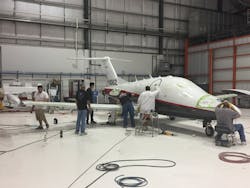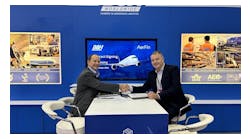As anybody who’s been around for any length of time in this business can attest there’s been a visual and material revolution in the application of aerospace coatings of late. One of the leaders of the pack is Sherwin-Williams Aerospace, formulator of sophisticated, even stunning, coatings for everything from general aviation aircraft to commercial jets.
As those coatings grow ever more sophisticated there’s a need as never before to train the technicians to apply the stuff right.
To that end “We conduct about six internal training courses per year” in the company’s Andover, KS, headquarters says Richard Giles, global technical services and training manager for Sherwin-Williams Aerospace.
You just don’t walk into one of the two-day sessions in Andover, “The training requires an application form ahead of time,” says Giles. “Applicants write a formal description of why they’re attending and the products of interest, so that we get an idea of why they’re actually there.”
Training costs vary a great deal says Giles, depending on a trainee’s needs. Maybe it’s new technology, perhaps a new generation of materials. “Each training course is tailored to [their] needs.” Flexibility is in, rigidity out when it comes to devising paint shop training efforts. Giles says, “We don’t have a rigid training course per se, because when we have four or five trainees signing up for our internal courses, they may have specific issues. What we don’t want to do is make these particular guys aware of paint issues they will never, ever see.”
In addition to the half-dozen or so fixed sessions in Andover, Sherwin-Williams trains at any customer location. It’s not unusual for a company to have two or three shifts. In such cases “It’s impossible to gather the paint shop [crew] and bring them to our facility. We take our toolbox of tricks and information and go to [them].”
So, What’s New?
That bag of tricks covers a wide array of new materials, new technologies, and the techniques to make them work right.
The aerospace coating’s industry demands the latest technology. Example: non-chromium pretreatments and primers for the exterior of all classes of aircraft. Sherwin-Williams offers both chrome and non-chrome technology aerospace paints for the exterior of the aircraft. While chromium-based coatings are still used to protect interior structure, Sherwin-Williams has shifted its aerospace emphasis to multi-coat basecoat/clearcoat systems.
The move has released the inner artisan in paint shop personnel. “The livery, the [visual] design of the aircraft is becoming very bold,” says Giles. “Straight lines are out of fashion. Free space is in. Usually, many colors are involved in the same aircraft frame.” Doing it right today “takes a different approach, a different understanding.”
Micas play an important part in bringing new liveries to life. “The mica is a very small translucent disc, which emits light at different levels and angles, and has a very pleasing visual effect,” says Giles, one rich with depth and texture. It will reflect several different colors at one time.
You can bring out such pleasing colors via a two-stage application of basecoat/clearcoat. But to extract the very best visual effect lots of operators and OEMs are choosing a three-stage approach says Giles. “The three-stage system produces a very vibrant color palette, very often a light color, a mica white,” he says. “It requires a white coating be laid down on top of a prepared surface. Then the mica itself, then the clear coat. So, there are three layers to that system.”
Traditional acrylic coatings are the easiest aerospace coatings to apply, and Sherwin-Williams offers a comprehensive selection of this technology. They’re still “very popular” says Giles. These conventional solid, metallic and mica coatings are used even where VOCs are not an issue. Giles says acrylics remain “very user-friendly.”
Either way, getting the application right remains paramount. Wringing the best from aircraft coatings can be, ah, “demanding,” says Giles. It all starts with getting the basic principles right.
“It’s not a ‘black art,’” he says. “Once you have these principles in place application of all aerospace coatings, including the new micas, tend to be relatively easy."
• First, Make absolutely sure you understand your client’s expectations. Commercial aircraft operate under decidedly different downtime constraints than business aviation or general aviation craft.
• Don’t scrimp on equipment, and make sure employees know how to use it. Giles says you should “make sure the paint is conditioned to room temperature. We shake [it]. We make sure the components of the material are added accordingly to the product data sheet. We allow the material to ‘induct’ … or sweat. This makes them chemically homogeneous."
• Each training course has the trainee help assemble the spray gun, making sure the fluid rate and the air pressure are right. Then instructors have the trainee spray a panel and check to make sure the paint pattern leaves neither runs nor exhibits dry spray spots. “Ninety-nine percent of the time [trainees] are amazed that they can apply a membrane of paint that looks glossy,” says Giles -- but without glitches.
Giles’ colleague, Julie Voisin, is Sherwin-Williams Aerospace’s global marketing manager. To his list of must-do’s she adds some basic A, B, Cs for success. “We always start and go back to the fundamentals: is the surface properly prepared? Is the equipment set properly? Are they mixing the product properly? ... That’s a big part of the training program. Because if you do the fundamentals right it has a direct correlation as to how that final finish looks.”
All of this is simple in its principle, demanding in its execution. Giles believes Sherwin-Williams’ far-flung training courses “are very descriptive,” The idea is not just to check the box on the employee’s work record to indicate he showed up but to render the course relevant “so that it has a big impact on their lives. We focus on the issues and the products, so that they walk away with a great deal more information than they walk in with.”




